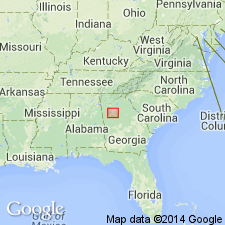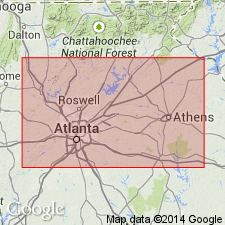
- Usage in publication:
-
- Ben Hill Granite*
- Modifications:
-
- Named
- Dominant lithology:
-
- Granite
- AAPG geologic province:
-
- Piedmont-Blue Ridge province
Summary:
The Ben Hill Granite, informally named by Pinson and others (1957), is here named in Fulton Co., GA. It is a coarse-grained, porphyritic granite batholith which intrudes the Clarkston, Stonewall, Wahoo Creek, and Clairmont Formations and the Norcross Gneiss, all of the Atlanta Group. The contact zone is marked by dikes and sills of Ben Hill Granite alternating with altered country rocks. Age is 325 m.y. (Mississippian to Pennsylvanian) based on zircon ages.
Source: GNU records (USGS DDS-6; Reston GNULEX).

- Usage in publication:
-
- Ben Hill Granite*
- Modifications:
-
- Age modified
- AAPG geologic province:
-
- Piedmont-Blue Ridge province
Summary:
Age of Ben Hill Granite changed to Carboniferous based on preliminary U-Pb zircon ages and because it lacks metamorphic foliation except near Brevard fault zone.
Source: GNU records (USGS DDS-6; Reston GNULEX).
For more information, please contact Nancy Stamm, Geologic Names Committee Secretary.
Asterisk (*) indicates published by U.S. Geological Survey authors.
"No current usage" (†) implies that a name has been abandoned or has fallen into disuse. Former usage and, if known, replacement name given in parentheses ( ).
Slash (/) indicates name conflicts with nomenclatural guidelines (CSN, 1933; ACSN, 1961, 1970; NACSN, 1983, 2005, 2021). May be explained within brackets ([ ]).

